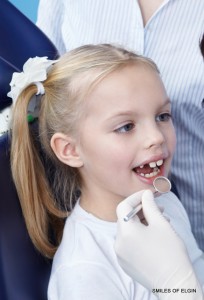1209 Dundee Avenue Elgin, IL 60120
Early Orthodontic Treatment
Early orthodontic treatment is necessary in order to prevent and correct “bite” irregularities. There are few predisposing factors which may contribute to irregularities, including genetic factors, the early loss of primary teeth, and damaging oral habits (such as thumb sucking and developmental problems).
These orthodontic irregularities may be present at birth or develop during toddlerhood or early childhood. During the preventative visits, the pediatric dentist is able to utilize many diagnostic tools to monitor orthodontic irregularities and, if necessary, implement early intervention strategies. Children should have an initial orthodontic evaluation around the age of seven.
Why does early orthodontic treatment make sense?
Some children display early signs of minor orthodontic irregularities. In such cases, the pediatric dentist may choose to monitor the situation over time without providing intervention. In other cases, children who display severe orthodontic irregularities, early orthodontic treatment can provide many benefits, including:

- Enhanced self-confidence and esthetic appearance.
- Increased likelihood of proper jaw growth.
- Increased likelihood of properly aligned and spaced adult teeth.
- Reduced risk of bruxing
- Reduced risk of childhood cavities, periodontal disease, and tooth decay.
- Reduced risk of impacted adult teeth.
- Reduced risk of protracted orthodontic treatments in later years.
- Reduced risk of speech problems.
- Reduced risk of tooth, gum, and jawbone injury.
When can my child begin early orthodontic treatment?
Pediatric dentists recognize three age-related stages of orthodontic treatment. These stages are:
Stage 1: Early treatment (2-6 years old)
Early orthodontic treatment aims to regulate the width of both dental arches. The main goal of early treatment is to provide enough space for the permanent teeth to erupt correctly. Good candidates for early treatment include: children who have difficulty biting properly, children who lose baby teeth early, children whose jaws click or grind during movement, bruxers, and children who use the mouth to breathe.
During the early treatment phase, the pediatric dentist works with parents and children to eliminate orthodontically harmful habits, like excessive pacifier use and thumb sucking.
Stage 2: Middle dentition (6-12 years old)
The goals of middle dentition treatments are to realign wayward jaws, to start to correct crossbites, and to begin the process of gently straightening misaligned permanent teeth. Middle dentition marks a developmental period when the soft and hard tissues are extremely pliable. Again, the dentist may provide the child with a dental appliance. Some orthodontic appliances (like braces) are fixed and others are removable. Regardless of the appliance, the child will still be able to speak, eat, and chew in a normal fashion. It is important to note that children who are fitted with fixed dental appliances should take extra care to clean the entire oral region each day in order to reduce the risk of staining, decay, and later cosmetic damage.
Stage 3: Adolescent dentition (13+ years old)
Some of the main goals of adolescent dentition include straightening the permanent teeth, and improving the esthetic appearance of the smile. Most commonly during this period, the dentist will provide fixed or removable “braces” to gradually straighten the teeth. Upon completion of the orthodontic treatment, the adolescent may be required to wear a retainer in order to prevent the regression of the teeth to their original alignment.
Office Hours
| Monday | 10:00 to 6:00 |
| Tuesday | 10:00 to 6:00 |
| Wednesday | 11:00 to 8:00 |
| Thursday | 10:00 to 6:00 |
| Friday | 10:00 to 6:00 |
| Saturday | 8:00 to 3:00 |
| Sunday | Appointment only |



Recent Comments